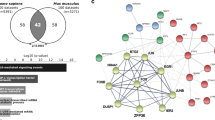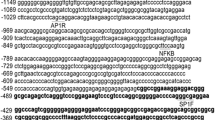Abstract
The peroxisome proliferator-activated receptor gamma 1 (PPARγ1) is a nuclear receptor that plays a pivotal role in breast cancer and is highly over-expressed relative to normal epithelia. We have previously reported that the expression of PPARγ1 is mediated by at least six distinct promoters and expression in breast cancer is driven by a tumor-specific promoter (pA1). Deletional analysis of this promoter fragment revealed that the GC-rich, 263 bp sequence proximal to the start of exon A1, is sufficient to drive expression in breast cancer cells but not in normal, human mammary epithelial cells (HMEC). By combining the disparate technologies of microarray and computer-based transcription factor binding site analyses on this promoter sequence the myc-associated zinc finger protein (MAZ) was identified as a candidate transcription factor mediating tumor-specific expression. Western blot analysis and chromatin immunoprecipitation assays verify that MAZ is overexpressed in MCF-7 cells and is capable of binding to the 263 bp promoter fragment, respectively. Furthermore, the over-expression of MAZ in HMEC is sufficient to drive the expression of PPARγ1 and does so by recruiting the tumor-specific promoter. This results in an increase in the amount of PPARγ1 capable of binding to its DNA response element. These findings help to define the molecular mechanism driving the high expression of PPARγ1 in breast cancer and raise new questions regarding the role of MAZ in cancer progression.




Similar content being viewed by others
References
American Cancer Society (2007) Cancer facts & figures 2007. American Cancer Society, Atlanta
Harris JR, Lippman ME, Veronesi U, Willett W (1992) Breast cancer (3). N Engl J Med 327(7):473–480
Kilgore MW, Tate PL, Rai S, Sengoku E, Price TM (1997) MCF-7 and T47D human breast cancer cells contain a functional peroxisomal response. Mol Cell Endocrinol 129(2):229–235
Kliewer SA, Forman BM, Blumberg B, Ong ES, Borgmeyer U, Mangelsdorf DJ et al (1994) Differential expression and activation of a family of murine peroxisome proliferator-activated receptors. Proc Natl Acad Sci USA 91(15):7355–7359
Tontonoz P, Hu E, Graves RA, Budavari AI, Spiegelman BM (1994) mPPAR gamma 2: tissue-specific regulator of an adipocyte enhancer. Genes Dev 8(10):1224–1234
Elstner E, Muller C, Koshizuka K, Williamson EA, Park D, Asou H et al (1998) Ligands for peroxisome proliferator-activated receptorgamma and retinoic acid receptor inhibit growth and induce apoptosis of human breast cancer cells in vitro and in BNX mice. Proc Natl Acad Sci USA 95(15):8806–8811
Yee LD, Guo Y, Bradbury J, Suster S, Clinton SK, Seewaldt VL (2003) The antiproliferative effects of PPARgamma ligands in normal human mammary epithelial cells. Breast Cancer Res Treat 78(2):179–192
Mueller E, Smith M, Sarraf P, Kroll T, Aiyer A, Kaufman DS et al (2000) Effects of ligand activation of peroxisome proliferator-activated receptor gamma in human prostate cancer. Proc Natl Acad Sci USA 97(20):10990–10995
Zhu Y, Alvares K, Huang Q, Rao MS, Reddy JK (1993) Cloning of a new member of the peroxisome proliferator-activated receptor gene family from mouse liver. J Biol Chem 268(36):26817–26820
Girard J (2002) [PPARgamma and insulin resistance]. Ann Endocrinol (Paris) 63(2 Pt 2):1S19–1S22
Barak Y, Nelson MC, Ong ES, Jones YZ, Ruiz-Lozano P, Chien KR et al (1999) PPAR gamma is required for placental, cardiac, and adipose tissue development. Mol Cell 4(4):585–595
Forman BM, Tontonoz P, Chen J, Brun RP, Spiegelman BM, Evans RM (1995) 15-Deoxy-delta 12, 14-prostaglandin J2 is a ligand for the adipocyte determination factor PPAR gamma. Cell 83(5):803–812
Kliewer SA, Lenhard JM, Willson TM, Patel I, Morris DC, Lehmann JM (1995) A prostaglandin J2 metabolite binds peroxisome proliferator-activated receptor gamma and promotes adipocyte differentiation. Cell 83(5):813–819
Kliewer SA, Sundseth SS, Jones SA, Brown PJ, Wisely GB, Koble CS et al (1997) Fatty acids and eicosanoids regulate gene expression through direct interactions with peroxisome proliferator-activated receptors alpha and gamma. Proc Natl Acad Sci USA 94(9):4318–4323
Thoennes SR, Tate PL, Price TM, Kilgore MW (2000) Differential transcriptional activation of peroxisome proliferator-activated receptor gamma by omega-3 and omega-6 fatty acids in MCF-7 cells. Mol Cell Endocrinol 160(1–2):67–73
Fajas L, Auboeuf D, Raspe E, Schoonjans K, Lefebvre AM, Saladin R et al (1997) The organization, promoter analysis, and expression of the human PPARgamma gene. J Biol Chem 272(30):18779–18789
Wang X, Southard RC, Kilgore MW (2004) The increased expression of peroxisome proliferator-activated receptor-gamma1 in human breast cancer is mediated by selective promoter usage. Cancer Res 64(16):5592–5596
Allred CD, Kilgore MW (2005) Selective activation of PPARgamma in breast, colon, and lung cancer cell lines. Mol Cell Endocrinol 235(1–2):21–29
Saez E, Tontonoz P, Nelson MC, Alvarez JG, Ming UT, Baird SM et al (1998) Activators of the nuclear receptor PPARgamma enhance colon polyp formation. Nat Med 4(9):1058–1061
Sato H, Ishihara S, Kawashima K, Moriyama N, Suetsugu H, Kazumori H et al (2000) Expression of peroxisome proliferator-activated receptor (PPAR)gamma in gastric cancer and inhibitory effects of PPARgamma agonists. Br J Cancer 83(10):1394–1400
Inoue K, Kawahito Y, Tsubouchi Y, Yamada R, Kohno M, Hosokawa Y et al (2001) Expression of peroxisome proliferator-activated receptor (PPAR)-gamma in human lung cancer. Anticancer Res 21(4A):2471–2476
Shappell SB, Gupta RA, Manning S, Whitehead R, Boeglin WE, Schneider C et al (2001) 15S-Hydroxyeicosatetraenoic acid activates peroxisome proliferator-activated receptor gamma and inhibits proliferation in PC3 prostate carcinoma cells. Cancer Res 61(2):497–503
Chung SH, Onoda N, Ishikawa T, Ogisawa K, Takenaka C, Yano Y et al (2002) Peroxisome proliferator-activated receptor gamma activation induces cell cycle arrest via the p53-independent pathway in human anaplastic thyroid cancer cells. Jpn J Cancer Res 93(12):1358–1365
Yee LD, Sabourin CL, Liu L, Li HM, Smith PJ, Seewaldt V et al (1999) Peroxisome proliferator-activated receptor gamma activation in human breast cancer. Int J Oncol 15(5):967–973
Mehta RG, Williamson E, Patel MK, Koeffler HP (2000) A ligand of peroxisome proliferator-activated receptor gamma, retinoids, and prevention of preneoplastic mammary lesions. J Natl Cancer Inst 92(5):418–423
Mueller E, Sarraf P, Tontonoz P, Evans RM, Martin KJ, Zhang M et al (1998) Terminal differentiation of human breast cancer through PPAR gamma. Mol Cell 1(3):465–470
Girnun GD, Smith WM, Drori S, Sarraf P, Mueller E, Eng C et al (2002) APC-dependent suppression of colon carcinogenesis by PPARgamma. Proc Natl Acad Sci USA 99(21):13771–13776
Nicol CJ, Yoon M, Ward JM, Yamashida M, Fukamachi K, Peters JM et al (2004) PPAR{gamma} influences susceptibility to DMBA-induced mammary, ovarian and skin carcinogenesis. Carcinogenesis 25:1747–1755
Saez E, Rosenfeld J, Livolsi A, Olson P, Lombardo E, Nelson M et al (2004) PPAR gamma signaling exacerbates mammary gland tumor development. Genes Dev 18(5):528–540
Sporn MB, Suh N, Mangelsdorf DJ (2001) Prospects for prevention and treatment of cancer with selective PPARgamma modulators (SPARMs). Trends Mol Med 7(9):395–400
Schug J, Overton GC (1997) TESS: transcription element search software on the WWW. In: Technical Report CBIL-TR-1997-1001-v00. Computational Biology and Informatics Laboratory, School of Medicine, University of Pennsylvania, Pennsylvania
Petsko G (2003) Modeling structure from sequence. In: Baxevanis AD (ed) Current protocols in bioinfomatics. Wiley, Indianapolis
Acknowledgments
We would like to thank Dr Victoria Seewaldt from Duke University for her generosity in sharing unpublished data. We also appreciate the assistance with experimental design and statistical analysis from Drs Kuey-Chu Chen, Arnold Stromberg and Eric Blalock from the University of Kentucky. This work was supported by grants CA95609-01 to MWK, grants 5-K12-DA-14040-05 and NCRR-P20-RR15592 to MWK and MEW, grant HL073693 to MEW, CA117235-02 from the NIH to DRT, and grant W81XWH-04-1-0532 to CDA.
Author information
Authors and Affiliations
Corresponding author
Rights and permissions
About this article
Cite this article
Wang, X., Southard, R.C., Allred, C.D. et al. MAZ drives tumor-specific expression of PPAR gamma 1 in breast cancer cells. Breast Cancer Res Treat 111, 103–111 (2008). https://doi.org/10.1007/s10549-007-9765-7
Received:
Accepted:
Published:
Issue Date:
DOI: https://doi.org/10.1007/s10549-007-9765-7




